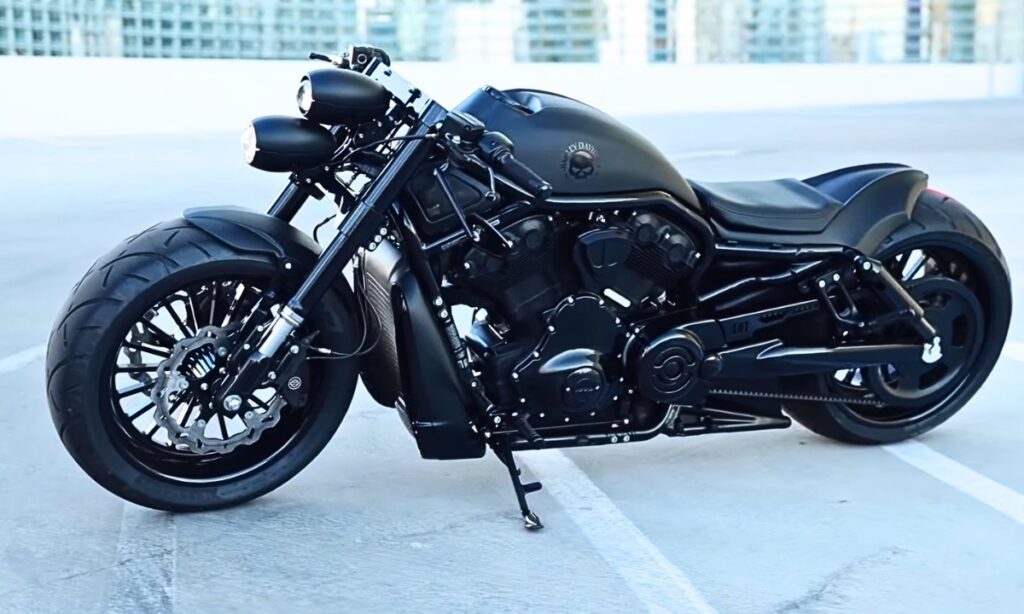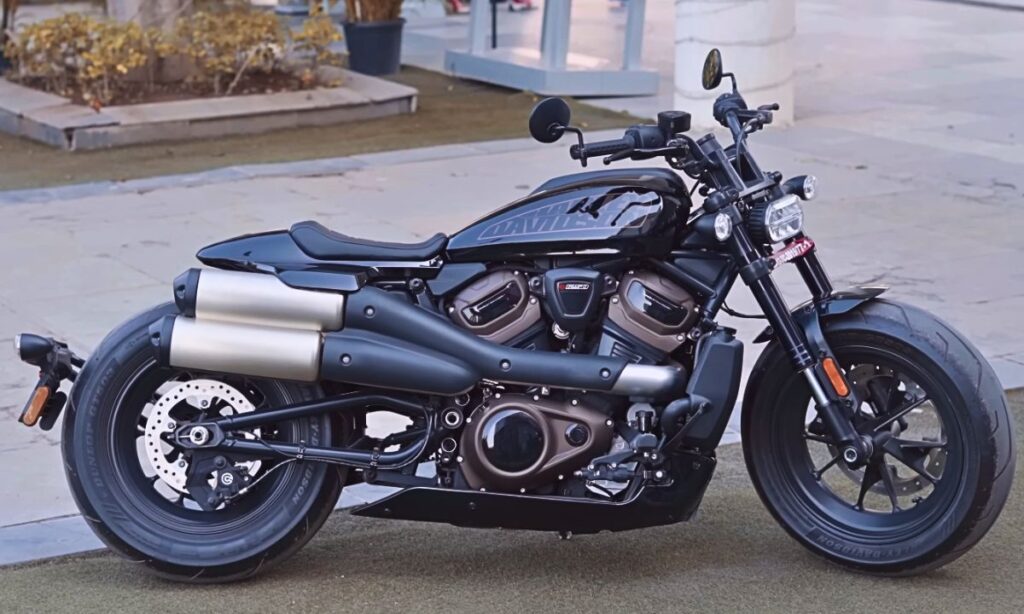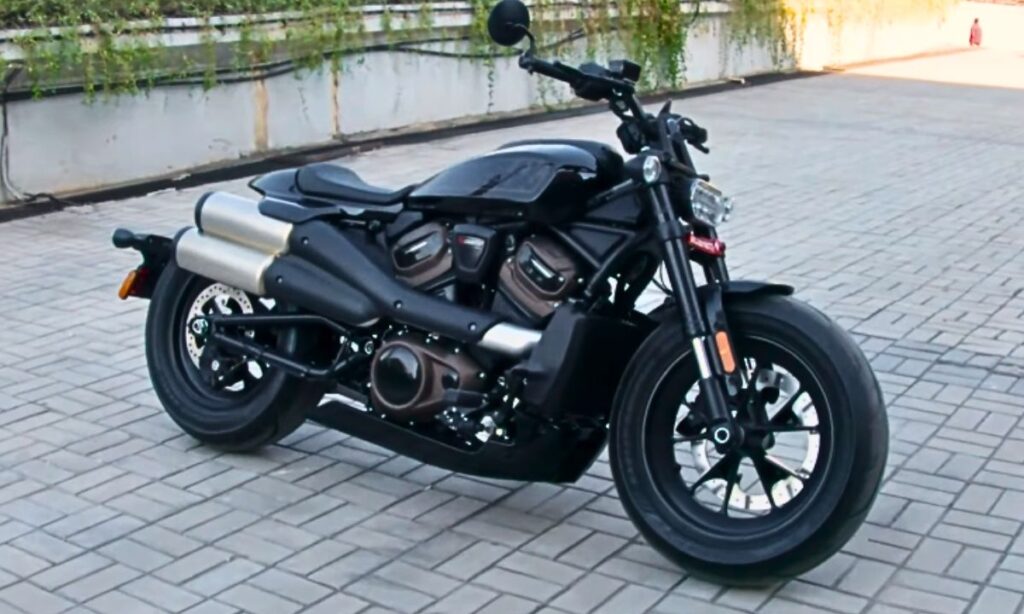If you’re a Harley rider, then you will know how important it is to maintain the right tire pressure on your motorcycle.
But if you’re not a regular user of the Harley bike, then it might be difficult for you to understand the right tire pressure for your specific Harley model.
So, we have compiled the list of all Harley Davidson model tire pressure charts with the manufacturer’s recommendations.
Harley Davidson Tire Pressure Chart

A crucial aspect of maintaining your Harley Davidson motorcycle’s performance and safety is proper tire pressure maintenance.
The Harley Davidson Tire Pressure Chart is a useful tool that provides recommended tire pressure levels for various Harley models.
It’s essential to refer to this chart regularly and ensure your bike’s tires are inflated to the correct pressure.
Over or under-inflation can result in suboptimal performance, increased wear, and even accidents.
Therefore, using the Harley Davidson Tire Pressure Chart to maintain optimal tire pressure is an integral part of Harley Davidson motorcycle upkeep.
Perfect Harley Davidson Tire Pressure
Maintaining the correct tire pressure is crucial for safe and enjoyable rides on your Harley Davidson motorcycle.
The perfect tire pressure for a Harley Davidson varies between models, but generally, it falls within the range of 36-40 PSI for the front tire and 40-44 PSI for the rear tire.
This range offers a balance between performance, comfort, and tire longevity.
You should always check your motorcycle’s manual or consult with the manufacturer for model-specific recommendations.
Regular checks and adjustments to ensure optimal tire pressure will not only enhance your riding experience but also promote tire durability and fuel efficiency.
Tire Pressure Chart Of All Harley Davidson Models
Harley-Davidson motorcycles come in a multitude of models, each with its own recommended tire pressure for optimal performance.
Here is the tire pressure chart for every Harley Davidson model:
| Harley Davidson Model | Front Tire Pressure (PSI) | Rear Tire Pressure (PSI) |
| Electra Glide | 36 | 40 |
| Fat Boy | 36 | 42 |
| Super Low Rider | 36 | 42 |
| Heritage Softail Classic | 36 | 40 |
| Low Rider ST | 28 | 40 |
| Harley Ultra Classic | 36 | 40 |
| Harley Ultra Limited | 36 | 40 |
| Street Rod | 32 | 36 |
| Dyna | 36 | 42 |
| Harley Road King | 36 | 40 |
| Harley Davidson 1200 Custom | 30 | 36 |
| Harley Low Rider | 32 | 36 |
| Pan America 1250 | 32 | 36 |
| Harley Forty Eight | 36 | 40 |
| Harley Forty-Eight Special | 36 | 40 |
| FXDC Super Glide | 30 | 36 |
| Harley Iron 883 | 30 | 40 |
| Harley Street Glide | 36 | 42 |
Tire Pressures For Different Rides
Tire pressure greatly influences the performance and comfort of your ride, whether you’re cycling on a smooth road, a rugged mountain trail, or a sandy beach.
Here are the perfect tire pressures for the different rides:
1. Tire Pressure On Highway
Higher speeds commonly associated with highway driving can increase tire temperature and, consequently, tire pressure.
Hence, it’s important to check your tire pressure before you start your journey when the tires are cold.
For highway rides, a tire pressure of approximately 36-40 psi for the front tire and 40-44 psi for the rear tire is recommended.
The over-inflated tires can reduce grip and lead to a harsher ride, whereas under-inflated tires can overheat and lead to tire failure.
2. Tire Pressure For Summer
When it comes to summer riding on your Harley Davidson, tire pressure is a crucial factor to take into account.
Heat causes air to expand, which can lead to overinflated tires if not monitored closely.
Overinflated tires can negatively impact the motorcycle’s handling and performance and increase the risk of a blowout.
Typically, the recommended tire pressure for a Harley during summer ranges from 36 to 40 PSI for the front tire and 40 to 44 PSI for the rear tire.
Therefore, it’s essential to regularly check your tire pressure during the summer months, ideally, to ensure optimal performance and safety.
3. Tire Pressure For Mountains
Mountain roads are often uneven, filled with sharp turns, and might have loose gravel.
In the mountains, you should keep tire pressure slightly lower than the manufacturer’s recommended range to increase traction.
You should also avoid underinflation or overinflation, which could lead to tire damage.
Important Things To Note Before Maintaining Tire Pressure On Harley Davidson
Maintaining the correct tire pressure on your Harley Davidson is crucial for optimal performance, safety, and longevity of your tires.
Here’s a comprehensive guide to consider:
1. Check the Manual
Always refer to your owner’s manual for the recommended tire pressure. Manufacturers’ guidelines are based on extensive testing and are designed to provide optimal performance.
2. Regular Checks
Tire pressure should be checked regularly, ideally every week, and definitely before any long trips.
Changes in outside temperature can affect tire pressure, so it’s important to keep an eye on it.
3. Use the Right Gauge
Use a reliable and accurate tire pressure gauge. There are different types of gauges: pencil-style, dial, and digital. Choose one that you find easy to read and use.
4. Check When Cold
Tires should be checked when they are cold (i.e., the bike hasn’t been ridden for at least three hours). Riding heats up the tires, which can cause the pressure to increase temporarily.
5. Don’t Overinflate
Never exceed the maximum pressure indicated on the tire sidewall. Overinflated tires can compromise your bike’s handling and lead to excessive wear.
6. Don’t Forget Valve Caps
Once you’re done checking and adjusting the tire pressure, make sure to screw the valve caps back on tightly.
They protect the valve from dust and debris and also help to prevent air leakage.
How Can You Measure Tire Pressure On Your Harley?
To accurately measure the tire pressure on your Harley, you’ll need a reliable tire pressure gauge. Here’s a step-by-step guide:
1. Purchase a Gauge
There are several types of tire pressure gauges available in the market: digital gauges, dial gauges, and stick gauges. Choose one that best suits your needs.
2. Check Tires When Cold
Tire pressure should be measured when the tires are cold, as pressure can increase with temperature.
If you’ve been riding your Harley, let it rest for a few hours before checking the pressure.
3. Recommended Tire Pressure
The recommended tire pressure for your Harley can usually be found in the owner’s manual. Make sure to stick to the manufacturer’s recommendation to ensure optimal performance.
4. Remove Valve Cap
The valve cap can be found on the outside of the tire. It’s small, round, and typically black. Unscrew it and keep it in a safe place.
5. Apply the Gaug
Place the tire pressure gauge onto the tire’s valve stem and press down. If you hear a hissing sound, it means that air is escaping; you need to press down harder.
6. Read the Gauge
Look at the reading on the gauge. If it matches the recommended pressure, you’re good to go.
If it’s too high, let some air out and measure again. If it’s too low, you’ll need to inflate the tire.
7. Replace Valve Cap
Once you’re done, screw the valve cap back onto the tire to prevent air from escaping and dust from getting in.
What Will Happen If Tire Is Under Inflating Or Over Inflating?
Tire inflation plays a crucial role in maintaining the safety and efficiency of a vehicle.
Under-inflated tires can lead to poor fuel economy, reduced handling, and even tire failure due to overheating from the increased friction between the tire and the road.
Over time, this can lead to premature tire wear or even a tire blowout, posing a significant safety risk.
On the other hand, over-inflated tires are equally problematic. They make the tire rigid and stiff, leading to a harsh ride and decreased traction.
In worse scenarios, over-inflated tires can cause the tread to wear more in the center than on the edges, reducing the tire’s overall lifespan.
In the event of a sudden impact, an over-inflated tire is more prone to puncture or burst.
Thus, maintaining the correct tire pressure is essential for vehicle safety, performance, and longevity.
Conclusion
The Harley Davidson, tire pressure chart, provides crucial information for maintaining the optimal performance and safety of your motorcycle.
Adhering to these guidelines ensures longer tire life, improved fuel economy, and a smoother ride.
Remember, regular tire pressure checks are essential for a safe and enjoyable riding experience.


Talha Younas, the brains behind the influential motorcycle-focused website, TwoWheller.com, is a dedicated and passionate advocate for biking culture. Born and raised in a family of motorcycle enthusiasts, his love for two-wheeled transportation was ignited at an early age. His commitment to providing in-depth reviews and helpful tips for riders has established him as a respected figure in the motorcycle community.

